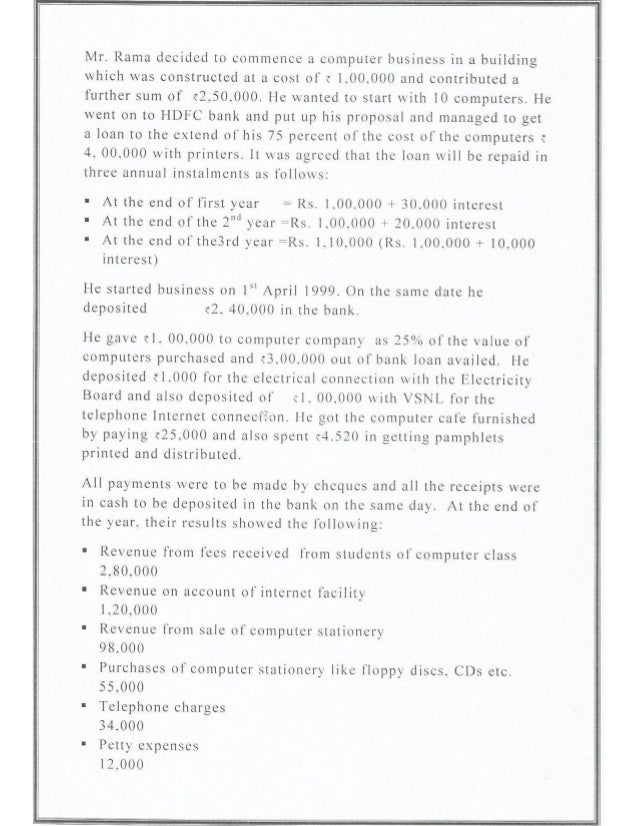Comprehensive Project Work In Accountancy Xii Free Download

Comprehensive Project Work In Accountancy Xii Free Download. Rajiv malhotra and jessica wedding. Solved Comprehensive Project Cbse Class 12 Accountancy Project Solved Accounting Ratios with Balance Sheet(vertical) and Statement of Profit and Loss - Cbse Class 12 Accountancy Project Solved Cash Flow Statements with Balance Sheet (vertical) and Notes to Accounts.
CBSE Class 12 Accountancy Syllabus for the academic session 2018 - 2019 is available here. Major changes are observed in the new syllabus.
Students preparing for Class 12 Accountancy Board exam are requested to note these changes carefully. Part A: Accounting for Not-for-Profit Organizations, Partnership Firms and Companies Unit 1: Financial Statements of Not-for-Profit Organizations • Not-for-profit organizations: concept. • Receipts and Payments Account: features and preparation. • Income and Expenditure Account: features, preparation of income and expenditure account and balance sheet from the given receipts and payments account with additional information. Unit 2: Accounting for Partnership Firms • Partnership: features, Partnership Deed. • Provisions of the Indian Partnership Act 1932 in the absence of partnership deed. • Fixed v/s fluctuating capital accounts.
Preparation of Profit and Loss Appropriation account- division of profit among partners, guarantee of profits. • Past adjustments (relating to interest on capital, interest on drawing, salary and profit sharing ratio). • Goodwill: nature, factors affecting and methods of valuation - average profit, super profit and capitalization. Note: Interest on partner's loan is to be treated as a charge against profits. Accounting for Partnership firms - Reconstitution and Dissolution. • Change in the Profit Sharing Ratio among the existing partners - sacrificing ratio, gaining ratio, accounting for revaluation of assets and reassessment of liabilities and treatment of reserves and accumulated profits. Preparation of revaluation account and balance sheet.
• Admission of a partner - effect of admission of a partner on change in the profit sharing ratio, treatment of goodwill (as per AS 26), treatment for revaluation of assets and reassessment of liabilities, treatment of reserves and accumulated profits, adjustment of capital accounts and preparation of balance sheet. • Retirement and death of a partner: effect of retirement / death of a partner on change in profit sharing ratio, treatment of goodwill (as per AS 26), treatment for revaluation of assets and reassessment of liabilities, adjustment of accumulated profits and reserves, adjustment of capital accounts and preparation of balance sheet. Preparation of loan account of the retiring partner. • Calculation of deceased partner’s share of profit till the date of death. Preparation of deceased partner’s capital account, executor’s account and preparation of balance sheet. • Dissolution of a partnership firm: types of dissolution of a firm.
Settlement of accounts -preparation of realization account, and other related accounts: capital accounts of partners and cash/bank a/c (excluding piecemeal distribution, sale to a company and insolvency of partner(s). Note: (i) The realized value of each asset must be given at the time of dissolution. (ii) In case, the realization expenses are borne by a partner, clear indication should be given regarding the payment thereof. Unit-3 Accounting for Companies Accounting for Share Capital • Share and share capital: nature and types.
Almost all driver scanners present you with a truly huge selection of revised drivers, and every one of them does the driver scan quickly and reliably, searching the impacted drivers and grabbing the up graded variants in seconds. So that you can get the particular driver brand, in case you need to manually handle the installation, it's best informed to be sure data derived out of the windows device manager, on-line forums not to mention in the vendor's web site. Protecting an extensive group of upgraded drivers on your pc is nearly impossible, in case you aim to manually locate and acquire each individual driver that demands updating. Digital blue qx5 windows 10. In the event that you try and remedy a specific crisis which originates from the flawed Digital Blue QX5(tm) Microscope understand that different drivers might have become damaged because of the damaged code, and as a consequence need replacing on top of that.
• Accounting for share capital: issue and allotment of equity shares, private placement of shares, Employee Stock Option Plan (ESOP). Public subscription of shares - over subscription and under subscription of shares; issue at par and at premium, calls in advance and arrears (excluding interest), issue of shares for consideration other than cash. • Concept of Private Placement and Employee Stock Option Plan (ESOP). • Accounting treatment of forfeiture and re-issue of shares.

• Disclosure of share capital in company’s Balance Sheet. Accounting for Debentures • Debentures: Issue of debentures at par, at a premium and at a discount. Issue of debentures for consideration other than cash; Issue of debentures with terms of redemption; debentures as collateral security-concept, interest on debentures. • Redemption of debentures: Lump sum, draw of lots and purchase in the open market (excluding ex interest and cum-interest). Creation of Debenture Redemption Reserve. Conversion method Note: Related sections of the Indian Companies Act, 2013 will apply. Part B: Financial Statement Analysis Unit 4: Analysis of Financial Statements • Financial statements of a company: Statement of Profit and Loss and Balance Sheet in the prescribed form with major headings and sub headings (as per Schedule III to the Companies Act, 2013).
Note: Exceptional items, extraordinary items and profit (loss) from discontinued operations are excluded. • Financial Statement Analysis: Objectives, importance and limitations. • Tools for Financial Statement Analysis: Comparative statements, common size statements, cash flow analysis, ratio analysis. • Accounting Ratios: Objectives, classification and computation. Liquidity Ratios: Current ratio and Quick ratio. Solvency Ratios: Debt to Equity Ratio, Total Asset to Debt Ratio, Proprietary Ratio and Interest Coverage Ratio. Activity Ratios: Inventory Turnover Ratio, Trade Receivables Turnover Ratio, Trade Payables Turnover Ratio and Working Capital Turnover Ratio.